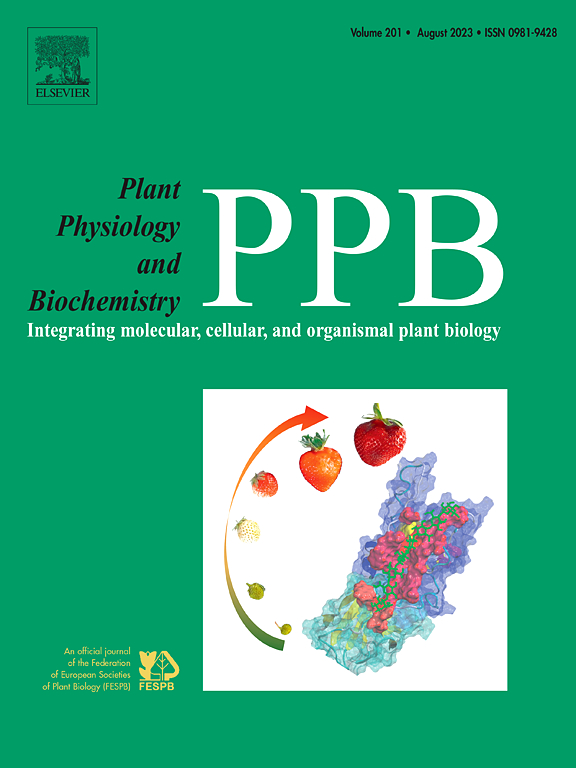Characterization of camptothecin biosynthesis in endophytic fungus from Camptotheca acuminate
IF 5.7
2区 生物学
Q1 PLANT SCIENCES
引用次数: 0
Abstract
Camptothecin (CPT), a well-known terpene indole alkaloid (TIA), exhibits anti-cancer activity by inhibiting the activity of eukaryotic topoisomerase I. The reliance on camptothecin (CPT) extraction from medicinal plants limites pharmaceutical manufacturing output. In this study, an endophytic fungus producing CPT was isolated from the seeds of Camptotheca acuminata and identified as Aspergillus tennesseensis based on morphological characteristics and molecular sequence. The CPT production was identified and quantified by High Performance Liquid Chromatography (HPLC) and High Performance Liquid Chromatography coupled to mass spectrometry (LC/MS). The intermediates of the CPT pathway, including strictosidine and strictosidinic acid, were identified using Ultra Performance Liquid Chromatography coupled to quadrupole time-of-flight electrospray ionization mass spectrometer (UPLC-QTOF-MS). These findings suggested that the endophytic fungus A. tennesseensis might harbor two CPT pathways that complemented C. acuminate via the central intermediate of strictosidinic acid. Notably, A. tennesseensis exhibited strong biotransformation, preferentially producing 10-hydroxycamptothecin over 9-hydroxycamptothecin. In C. acuminate, 10-hydroxycamptothecin increased by 224 % on the 4th day after feeding with endophyte A. tennesseensis. Treatment with 1 % methanol significantly enhanced CPT production of A. tennesseensis, resulting in a 9-fold increase (48.9 ng/g to 441.2 ng/g) in mycelium and 14.5-fold increase (0.9 μg/L to 13.4 μg/L) in culture medium, respectively. The finding of the complete CPT pathway intermediates provides us novel insights into fungal-derived camptothecin biosynthesis. The discovery of high efficient hydroxylation and methanol elicitor reveals the potential of A. tennesseensis as an alternative CPT source.

喜树内生真菌合成喜树碱的研究
喜树碱(CPT)是一种众所周知的萜烯吲哚生物碱(TIA),通过抑制真核生物拓扑异构酶i的活性而具有抗癌活性,对药用植物中喜树碱(CPT)提取的依赖限制了制药产量。本研究从喜树(Camptotheca acuminata)种子中分离到一种产CPT的内生真菌,根据形态特征和分子序列鉴定为曲霉(Aspergillus tenseensis)。采用高效液相色谱法(HPLC)和高效液相色谱-质谱法(LC/MS)对CPT的生产进行鉴定和定量。采用超高效液相色谱-四极杆飞行时间电喷雾质谱仪(UPLC-QTOF-MS)鉴定了CPT途径的中间体,包括strictosidine和strictosidic acid。这些结果表明,内生真菌A. tennessee可能有两条CPT通路,通过缩藤sidic酸的中心中间体与C. acuminate互补。值得注意的是,田纳西松表现出较强的生物转化能力,优先产生10-羟基喜树碱而不是9-羟基喜树碱。在加食内生菌后第4天,10-羟基喜树碱含量增加了224%。1%甲醇处理显著提高了麻草CPT产量,菌丝体产量增加了9倍(48.9 ng/g ~ 441.2 ng/g),培养基产量增加了14.5倍(0.9 μg/L ~ 13.4 μg/L)。完整的CPT通路中间体的发现为我们提供了真菌来源的喜树碱生物合成的新见解。高效羟基化和甲醇激发剂的发现揭示了田纳西麻作为CPT替代来源的潜力。
本文章由计算机程序翻译,如有差异,请以英文原文为准。
求助全文
约1分钟内获得全文
求助全文
来源期刊
CiteScore
11.10
自引率
3.10%
发文量
410
审稿时长
33 days
期刊介绍:
Plant Physiology and Biochemistry publishes original theoretical, experimental and technical contributions in the various fields of plant physiology (biochemistry, physiology, structure, genetics, plant-microbe interactions, etc.) at diverse levels of integration (molecular, subcellular, cellular, organ, whole plant, environmental). Opinions expressed in the journal are the sole responsibility of the authors and publication does not imply the editors'' agreement.
Manuscripts describing molecular-genetic and/or gene expression data that are not integrated with biochemical analysis and/or actual measurements of plant physiological processes are not suitable for PPB. Also "Omics" studies (transcriptomics, proteomics, metabolomics, etc.) reporting descriptive analysis without an element of functional validation assays, will not be considered. Similarly, applied agronomic or phytochemical studies that generate no new, fundamental insights in plant physiological and/or biochemical processes are not suitable for publication in PPB.
Plant Physiology and Biochemistry publishes several types of articles: Reviews, Papers and Short Papers. Articles for Reviews are either invited by the editor or proposed by the authors for the editor''s prior agreement. Reviews should not exceed 40 typewritten pages and Short Papers no more than approximately 8 typewritten pages. The fundamental character of Plant Physiology and Biochemistry remains that of a journal for original results.

 求助内容:
求助内容: 应助结果提醒方式:
应助结果提醒方式:


